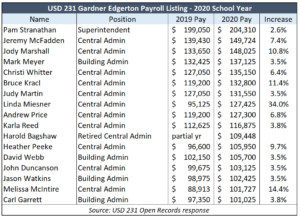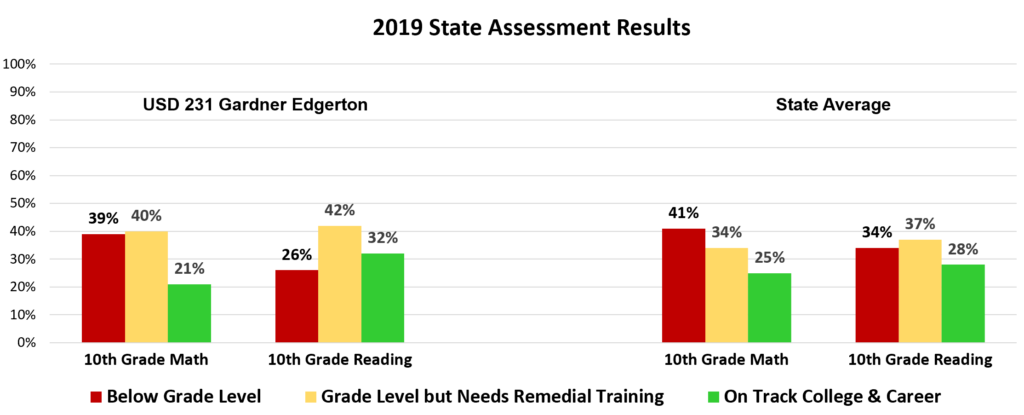USD 231 Gardner-Edgerton says average teacher pay increased 3.3% in the 2019-20 school year, but some district administrators received increases that were two to three times as much. Student achievement, meanwhile, has dropped over the years and is much lower than parents are led to believe in Kansas.
Superintendent Pam Stranathan’s pay increased 2.6% to $204,310 but the district confirms she also was provided with free family health coverage; the year before, she received free single coverage like all other employees. According to a report filed with the Kansas Department of Education, the added health coverage benefit cost about $14,000 more, pushing Stranathan’s pay plus fringe benefits compensation to $224,983 (not counting KPERS retirement benefits). That’s 9.2% more than USD 231 reported in pay and benefits for the previous year.
 Finance Director Jeremy McFadden got a 7.4% pay increase to $149,724 and Jody Marshall, Human Resource Director was paid 10.8% more, at $148,025.
Finance Director Jeremy McFadden got a 7.4% pay increase to $149,724 and Jody Marshall, Human Resource Director was paid 10.8% more, at $148,025.
Other administrators getting large increases include Christi Whitter (6.4% to $135,150), Linda Miesner (34% to $127,425), Andrew Price (6.8% to $127,300), Heather Peeke (9.7% to $105,950), and Melissa McIntire (14.4% to $101,727). None of these pay amounts include fringe benefits.
The complete payroll listing is available at KansasOpenGov.org.
Pay increased but student achievement declined
The windfall from court-ordered and legislator-approved funding increase is pushing employee and administrator pay higher, but student achievement declined significantly over the last few years.
According to the 2015 state assessment, 52% of students tested (Grades 3-8 and 10) were on track for college and career in Math and 50% were on track in English Language Arts. But the most recent assessment from 2019 shows only 39% are on track in both Math and ELA.
Results for 10th-graders are even lower.
The 2019 state assessment results from the Kansas Department of Education shows 39% of 10th-graders in Gardner Edgerton are below grade level in Math; 40% are considered to be at grade level but still need remedial training to be on track for college and career, and only 21% are on track.
Results for English Language Arts – labeled here as Reading – are a bit better but still surprisingly low, with 26% below grade level. 42% are at grade level but still need remedial training and just 32% are on track for college and career.

State average results are also much lower than parents and employers are led to believe by school districts.
41% of students are below grade level in Math, and 34% are below grade level in Reading. Only about a quarter of the state’s 10th-graders are on track for college and career.


